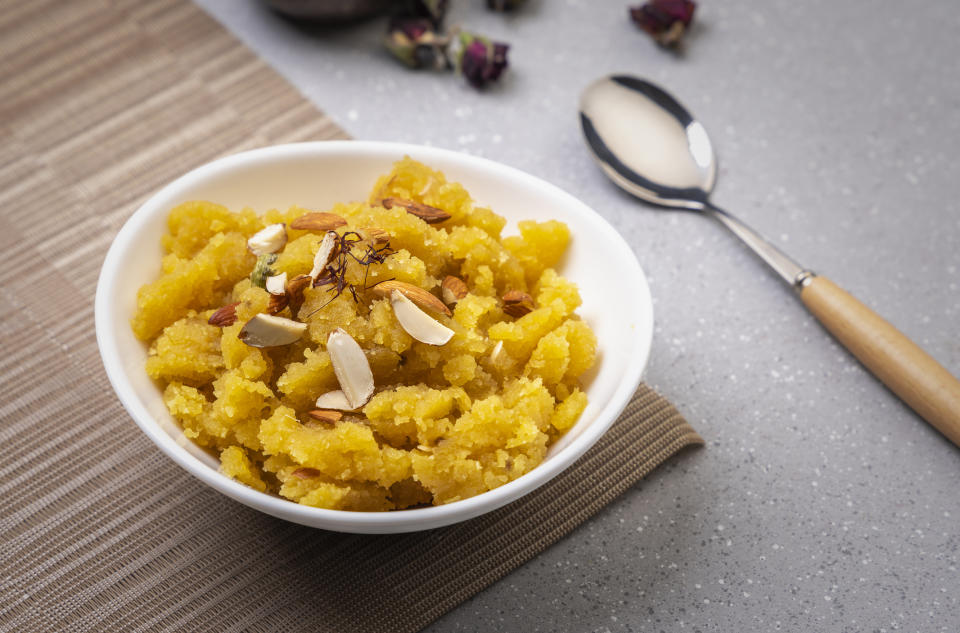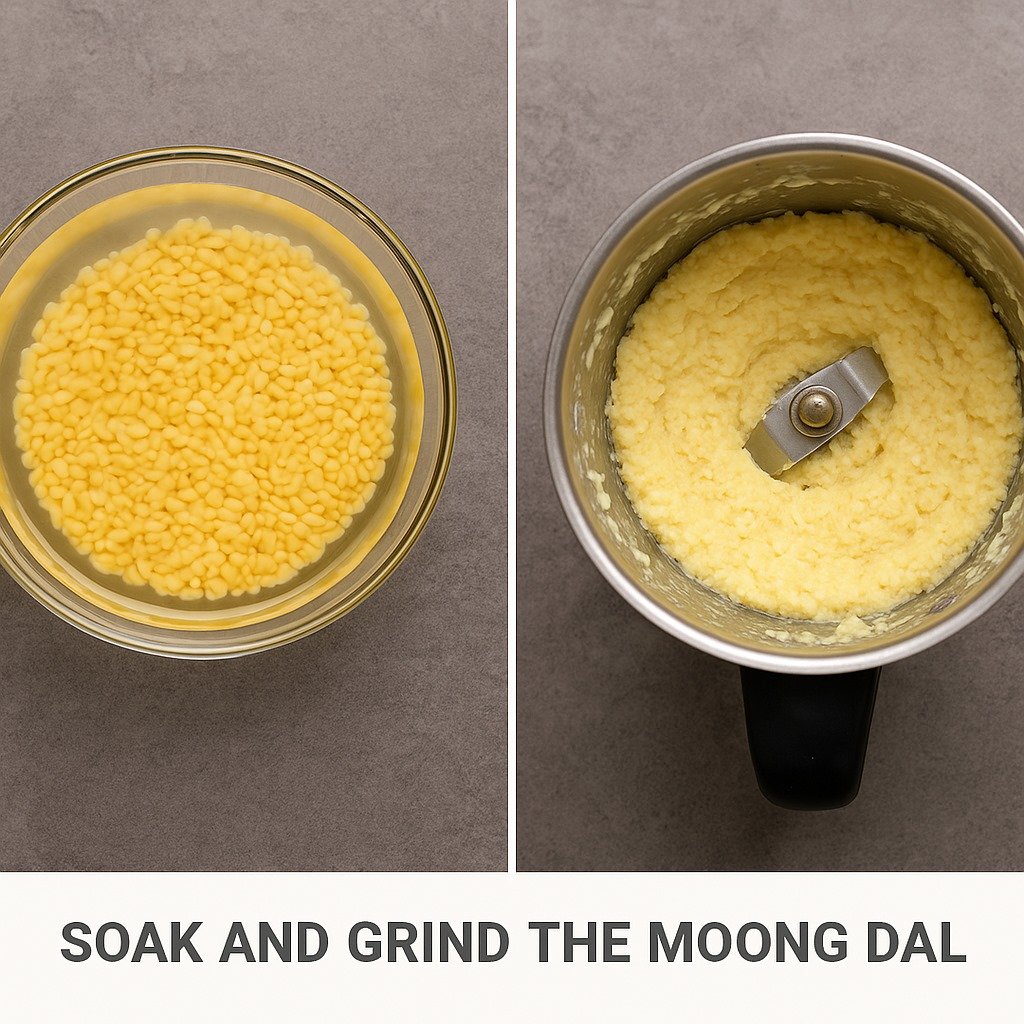
Moong Dal Halwa Recipe: A Rich, Protein-Packed Indian Dessert
Moong Dal Halwa is a classic Indian dessert that’s as indulgent as it is comforting. Made from split yellow moong dal, this rich, nutty, and aromatic sweet is a staple at festive occasions, weddings, and winter gatherings in India. Not only is it a treat for your taste buds, but it’s also packed with the nutritional goodness of moong dal, including a decent dose of protein.
In this blog, we’ll walk you through an easy yet authentic moong dal halwa recipe, and how much protein is in moong dal and is moong dal good for weight loss, and sharing tips to make this dessert a crowd-pleaser.
Why Moong Dal Halwa is a Must-Try Indian Dessert?

Moong dal halwa is a labor of love, requiring patience to roast the dal to perfection and stir it into a luscious, ghee-laden dessert. Its golden hue, fragrant cardamom, and crunchy nuts make it irresistible. Plus, moong dal (split yellow lentils) is a powerhouse of nutrients, making this halwa a guilt-free indulgence when enjoyed in moderation. Whether you’re hosting a festive gathering or craving a warm dessert on a chilly evening, this halwa recipe is your ticket to culinary bliss.
Moong Dal Halwa Recipe: Step-by-Step Guide
Servings: 4-6
Prep Time: 10 minutes (plus soaking time)
Cook Time: 45-50 minutes
Total Time: ~1 hour
Ingredients
– 1 cup moong dal (split yellow lentils)
– 1 cup ghee (clarified butter)
– 1 cup sugar (adjust to taste)
– 2 cups milk (warm)
– 1/4 tsp saffron strands (soaked in 2 tbsp warm milk, optional)
– 1/2 tsp cardamom powder
– 10-12 cashews, chopped
– 8-10 almonds, slivered
– 1 tbsp raisins
– 2 cups water (optional, for thinner consistency)
Instructions
- Soak and Grind the Moong Dal

– Rinse 1 cup of moong dal thoroughly under running water until the water runs clear.
– Soak the dal in water for 3-4 hours (or overnight for best results).
– Drain the water and grind the soaked dal into a coarse paste using minimal water. Set aside.
- Roast the Moong Dal

– Heat 3/4 cup of ghee in a heavy-bottomed pan or kadhai over low-medium heat.
– Add the ground moong dal paste and roast it, stirring continuously, for 20-25 minutes. The dal will turn aromatic, golden brown, and release a nutty fragrance. Be patient—this step is key to authentic flavour!
- Cook with Milk and Water
– Gradually add 2 cups of warm milk to the roasted dal, stirring constantly to avoid lumps.
– Optionally, add 1-2 cups of water for a softer texture. Cook on low heat until the dal absorbs the liquid (about 10 minutes).
- Add Sugar and Saffron
– Add 1 cup of sugar and mix well. The mixture will loosen as the sugar melts.
– Stir in the saffron-infused milk (if using) for a rich flavour and vibrant colour. Continue cooking until the halwa thickens again.
- Flavor with Ghee and Spices
– Add the remaining 1/4 cup of ghee and 1/2 tsp cardamom powder. Mix well and cook for another 5-7 minutes until the halwa pulls away from the sides of the pan.
- Garnish with Nuts
– In a small pan, heat 1 tsp ghee and lightly fry the cashews, almonds, and raisins until golden.
– Stir the nuts into the halwa, reserving a few for garnish.
- Serve and Enjoy
– Serve the moong dal halwa warm, garnished with extra nuts and a sprinkle of saffron strands. Pair it with a scoop of vanilla ice cream for a modern twist or enjoy it as is!
5 Tips for the Perfect Moong Dal Halwa Recipe

- Use a heavy-bottomed pan: Prevents burning and ensures even roasting.
- Low and slow roasting: High heat can burn the dal, ruining the flavor.
- Adjust sweetness: Taste and add more or less sugar based on preference.
- Make it vegan: Swap ghee for coconut oil and milk for almond or coconut milk.
- Storage: Store leftovers in an airtight container in the fridge for up to 5 days. Reheat with a splash of milk before serving.
Nutritional Benefits of Moong Dal
Beyond its deliciousness in halwa, moong dal offers:
- Protein: Supports muscle repair and growth.
- Fibre: Aids digestion and promotes gut health.
- Iron and folate: Boosts energy and supports blood health.
- Low in fat: Naturally low in unhealthy fats, though halwa adds ghee.
For a healthier twist, reduce the ghee and sugar in the recipe or pair the halwa with fresh fruits to balance the meal.
Make It Your Own Version
– Add flavors: Experiment with rose water, kewra essence, or a pinch of nutmeg for a unique twist.
– Go nut-free: Skip the nuts for a smoother texture or if you have allergies.
– Portion control: Serve in small bowls for a decadent yet controlled indulgence.
To Sum up
Moong dal halwa is more than just a dessert—it’s a celebration of Indian culinary tradition, packed with the wholesome goodness of moong dal. With its rich flavor, protein content, and versatility, this halwa recipe is perfect for festive occasions or a cozy night in. Whether you’re a seasoned cook or a beginner, this step-by-step guide ensures a drool-worthy result. Try it today, and let the aroma of roasted moong dal and ghee fill your kitchen with warmth and joy! To learn such nutritional recipe join our diploma in culinary skills program along with your on-going degree or right after your 10th or 12th. To know more call us on +91-9888011222!
Have you made moong dal halwa before? Share this moong dal recipe with friends and family and read our blogs for more delicious Indian recipes.
FAQs
How Much Protein Is in Moong Dal?
Moong dal is a fantastic source of plant-based protein. According to the USDA, 100 grams of raw moong dal contains approximately 24 grams of protein. When cooked, this reduces slightly due to water content, but a typical serving (1/2 cup cooked, ~100g) provides about 7-8 grams of protein. In moong dal halwa, the protein content is diluted by ghee, sugar, and milk, but it still contributes to your daily protein intake, making it a nutrient-dense dessert.
Is Moong Dal Good for Weight Loss?
Yes, moong dal can be a great addition to a weight loss diet when consumed in moderation. Here’s why:
– High in protein and fibre: Keeps you full longer, reducing cravings.
– Low glycemic index: Helps stabilize blood sugar levels, preventing overeating.
– Nutrient-dense: Packed with vitamins, minerals, and antioxidants.
However, moong dal halwa, while nutritious, is calorie-dense due to ghee and sugar. For weight loss, enjoy it sparingly as a treat and pair it with a balanced diet rich in vegetables, lean proteins, and whole grains.
Why Moong Dal Halwa Is Perfect for Every Occasion
– Festive Vibes: A staple at Diwali, Holi, and weddings, this halwa brings warmth and tradition to celebrations.
– Winter Comfort: Its rich, warming qualities make it ideal for cold days.
– Impress Guests: The unique texture and flavor of moong dal halwa make it a showstopper dessert.
– Nutritious Indulgence: With moong dal’s protein and micronutrients, it’s a dessert you can feel good about (in moderation!).




